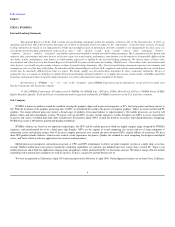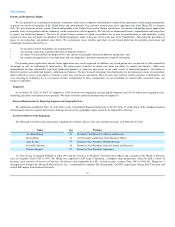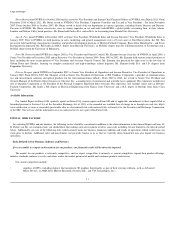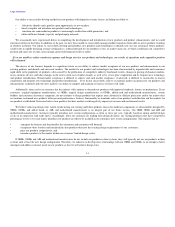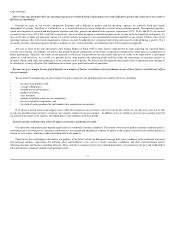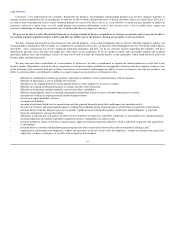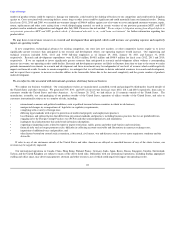NVIDIA 2012 Annual Report Download - page 13
Download and view the complete annual report
Please find page 13 of the 2012 NVIDIA annual report below. You can navigate through the pages in the report by either clicking on the pages listed below, or by using the keyword search tool below to find specific information within the annual report.
Table of Contents
•suppliers of system-on-chip products that support tablets, smartphones, portable media players, internet television, automotive
navigation and other similar devices, such as AMD, ARM Holdings plc, Broadcom Corporation, Freescale Semiconductor Inc.,
Fujitsu Limited, Imagination Technologies Ltd., Intel, Marvell Technology Group Ltd., NEC Corporation, Qualcomm Incorporated,
Renesas Technology Corp., Samsung Electronics Co. Ltd., Seiko Epson Corporation, ST-Ericsson, Texas Instruments Incorporated
and Toshiba America Electronic Components, Inc.;
• licensors of graphics technologies such as ARM Holdings plc and Imagination Technologies Group plc and
•suppliers of cellular basebands such as , Broadcom Corporation, Freescale Semiconductor Inc., HiSilicon Technologies Co., Ltd.,
Intel, Marvell Technology Group Ltd., Mediatek, Qualcomm Incorporated, Renesas Technology Corp., Samsung Electronics Co. Ltd.,
Spreadtrum Communications Co., Ltd, ST-Ericsson and Texas Instruments Incorporated.
We expect competition to increase from both existing competitors and new market entrants with products that may be less costly than ours, or may
provide better performance or additional features not provided by our products. In addition, it is possible that new competitors or alliances among competitors
could emerge and acquire significant market share. Furthermore, competitors with greater financial resources may be able to offer lower prices than us, or
they may offer additional products, services or other incentives that we may not be able to match. In addition, many of our competitors operate and maintain
their own fabrication facilities and have longer operating histories, greater name recognition, larger customer bases, and greater sales, marketing and
distribution resources than we do.
Our ability to compete will depend on, among other factors, our ability to:
• continue to keep pace with technological developments;
• develop and introduce new products, services, technologies and enhancements on a timely basis;
• transition our semiconductor products to increasingly smaller line width geometries;
• obtain sufficient foundry capacity and packaging materials; and
• succeed in significant foreign markets, such as China and India.
If we are unable to compete in our current or new markets, demand for our products could decrease which could cause our revenue to decline and our
financial results to suffer.
If and to the extent we offer products in new markets, we may face competition from existing competitors as well as from companies with which we
currently do not compete. We expect substantial competition from Intel and AMD, both of whom has a strategy of selling platform solutions, including
integrating a CPU and a GPU on the same chip or same package, as evidenced by AMD's announcement of its Fusion processors and Intel's announcement of
its family of CPUs codenamed Sandy Bridge. As Intel and AMD continue to pursue platform solutions and integrated CPUs, our business could be negatively
impacted.
We depend on foundries to manufacture our products and these third parties may not be able to satisfy our manufacturing requirements, which would
harm our business.
We do not manufacture the silicon wafers used for our products and do not own or operate a wafer fabrication facility. Instead, we are dependent on
industry-leading foundries, such as Taiwan Semiconductor Manufacturing Company Limited, or TSMC, to manufacture our semiconductor wafers using their
fabrication equipment and techniques. A substantial portion of our wafers are supplied by TSMC. The foundries, which have limited capacity, also
manufacture products for other semiconductor companies, including some of our competitors. Since we do not have long-term commitment contracts with
any of these foundries, they do not have an obligation to provide us with any set pricing or minimum quantity of product at any time except as may be
provided in a specific purchase order. Most of our products are only manufactured by one foundry at a time. In times of high demand, the foundries could
choose to prioritize their capacity for other companies, reduce or eliminate deliveries to us, or increase the prices that they charge us. If we are unable to meet
customer demand due to reduced or eliminated deliveries or have to increase the prices of our products, we could lose sales to customers, which would
negatively impact our revenue and our reputation.
Because the lead-time needed to establish a strategic relationship with a new manufacturing partner and achieve initial production could be over a year,
we do not have an alternative source of supply for our products. In addition, the time and effort to qualify a new foundry would result in additional expense,
diversion of resources, and could result in lost sales, any of which would negatively impact our financial results. We believe that long-term market acceptance
for our products will depend on reliable relationships with the third-party manufacturers we use to ensure adequate product supply and competitive pricing to
respond to customer demand.
12




